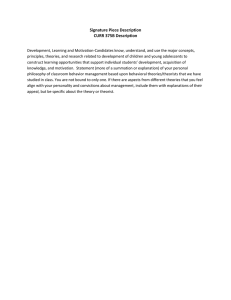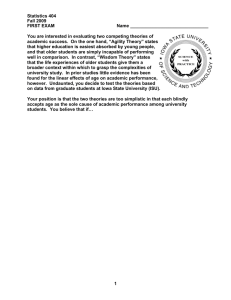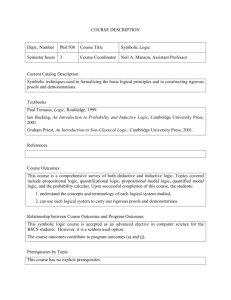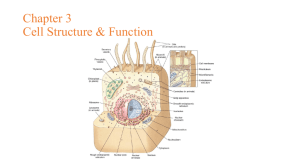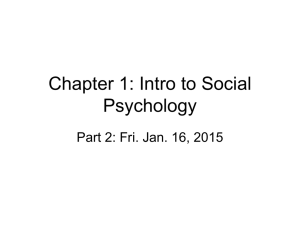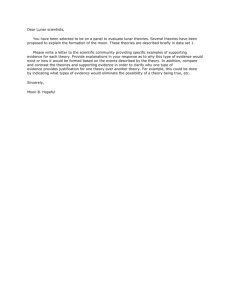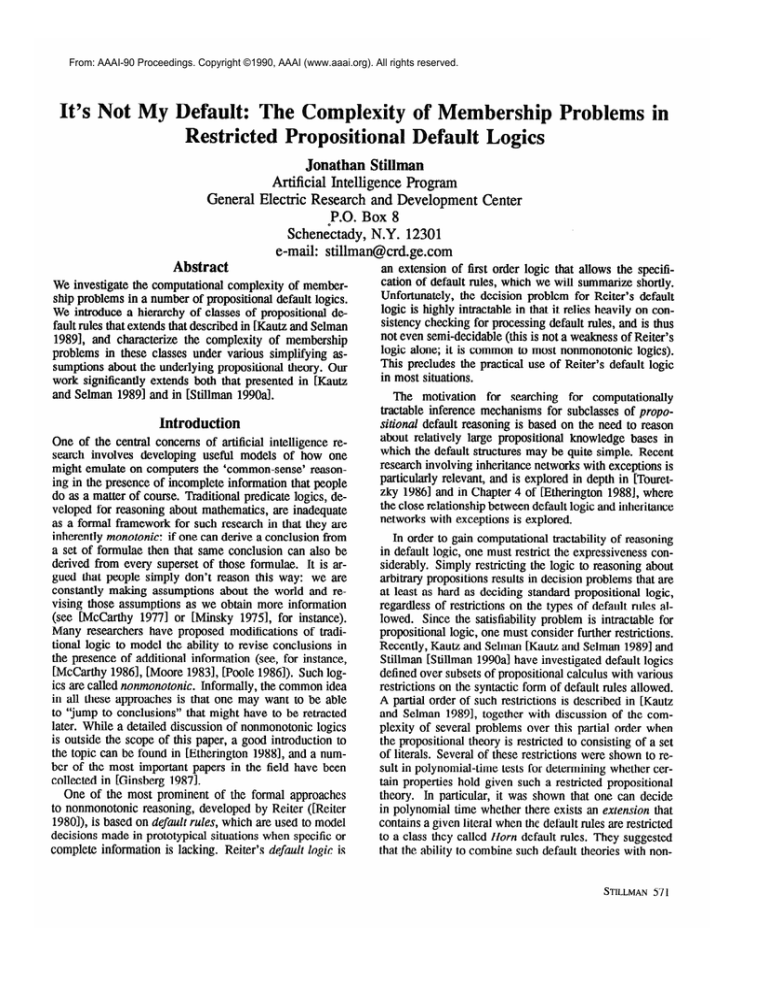
From: AAAI-90 Proceedings. Copyright ©1990, AAAI (www.aaai.org). All rights reserved.
It’s Not My Default: The Corn lexity of Membership
Restricted Propositional Default Logics
Problems i
Jonathan Stillman
Artificial Intelligence Program
General Electric Research and Development Center
P.O. Box 8
Schenectady, N.Y. 12301
e-mail: stillman@crd.ge.com
Abstract
an extension of first order logic that allows the specitiWe investigate the computational complexity of membership problems in a number of propositional default logics.
We introduce a hierarchy of classes of propositional default rules that extends that described in [Kautz and Selman
19891, and characterize the complexity of membership
problems in these classes under various simplifying assumptions about the underlying propositional theory. Our
work significantly extends both that presented in [Kautz
and Selman 19891 and in [Stillman 199Oal.
Introduction
One of the central concerns of artificial intelligence research involves developing useful models of how one
might emulate on computers the ‘common-sense’ reasoning in the presence of incomplete information that people
do as a matter of course. Traditional predicate logics, developed for reasoning about mathematics, are inadequate
as a formal framework for such research in that they are
inherently monotonic: if one can derive a conclusion from
a set of formulae then that same conclusion can also be
derived from every superset of those formulae. It is argued that people simply don’t reason this way: we are
constantly making assumptions about the world and revising those assumptions as we obtain more information
(see [McCarthy 19771 or [Minsky 19751, for instance).
Many researchers have proposed modifications of traditional logic to model the ability to revise conclusions in
the presence of additional information (see, for instance,
[McCarthy 19861, [Moore 19831, [Poole 19861). Such logits are called nonmonotonic. Informally, the common idea
in all these approaches is that one may want to be able
to “jump to conclusions” that might have to be retracted
later. While a detailed discussion of nonmonotonic logics
is outside the scope of this paper, a good introduction to
the topic can be found in [Etherington 19881, and a number of the most important papers in the field have been
collected in [Ginsberg 19871.
One of the most prominent of the formal approaches
to nonmonotonic reasoning, developed by Reiter ([Reiter
19801), is based on default rules, which are used to model
decisions made in prototypical situations when specific or
complete information is lacking. Reiter’s default logic is
cation of default rules, which we will summarize shortly.
Unfortunately, the decision problem for Reiter’s default
logic is highly intractable in that it relies heavily on consistency checking for processing default rules, and is thus
not even semi-decidable (this is not a weakness of Reiter’s
logic alone; it is common to most nonmonotonic logics).
This precludes the practical use of Reiter’s default logic
in most situations.
The motivation for searching for computationally
tractable inference mechanisms for subclasses of propositional default reasoning is based on the need to reason
about relatively large propositional knowledge bases in
which the default structures may be quite simple. Recent
research involving inheritance networks with exceptions is
particularly relevant, and is explored in depth in [Touretzky 19861 and in Chapter 4 of [Etherington 19881, where
the close relationship between default logic and inheritance
networks with exceptions is explored.
In order to gain computational tractability of reasoning
in default logic, one must restrict the expressiveness considerably. Simply restricting the logic to reasoning about
arbitrary propositions results in decision problems that are
at least as hard as deciding standard propositional logic,
regardless of restrictions on the types of default rules allowed. Since the satisfiability problem is intractable for
propositional logic, one must consider further restrictions.
Recently, Kautz and Selman [Kautz and Selman 19891 and
Stillman [Stillman 199Oal have investigated default logics
defined over subsets of propositional calculus with various
restrictions on the syntactic form of default rules allowed.
A partial order of such restrictions is described in [Kautz
and Selman 19891, together with discussion of the complexity of several problems over this partial order when
the propositional theory is restricted to consisting of a set
of literals. Several of these restrictions were shown to result in polynomial-time tests for determining whether certain properties hold given such a restricted propositional
theory. In particular, it was shown that one can decide
in polynomial time whether there exists an extension that
contains a given literal when the default rules are restricted
to a class they called Horn default rules. They suggested
that the ability to combine such default theories with nonSTILLMAN 571
default propositional Horn theories would be particularly
useful, but left open the question of whether the membership problem (i.e., determining whether there exists an
extension of a given default theory containing a specified
literal) for such a combination of theories is tractable. In
WiIlman 199Oa1,we showed that a restriction of this problem is NP-complete, and presented several related results.
The remainder of this paper is organized as follows:
we begin with a brief description of Reiter’s default logic,
followed by a short overview of NP-completeness, and
a presentation of the restrictions considered by Kautz and
Selman. Following this we introduce a hierarchy of classes
of propositional default rules that significantly extends that
presented in CKautz and Selman 19891. Next, we characterize the complexity of the membership problem for these
classes. Finally, we summarize the results presented in this
paper, and discuss related results and future work.
Preliminaries
Reiter’s Default Logic
For a detailed discussion of Reiter’s default logic the interested reader is referred to [Reiter 19801. In this section
we will simply review some of the immediately pertinent
ideas. A default theory is a pair (D, W), where W is a
set of closed well-formed formulae (wffs) in a first order
language and D is a set of default rules. A default rule
consists of a triple < a, p, y > : a is a formula called
the prerequisite, /3 is a set of formulae called the justijkations, and y is a formula called the conclusion. Informally,
a default rule denotes the statement “if the prerequisite is
true, and the justifications are consistent with what is believed, then one may infer the ConcZusion.” Default rules
are written
Cl!:0
Y
If the conclusion of a default rule occurs in the justifications, the default rule is said to be semi-normal; if the
conclusion is identical to the justifications the rule is said
to be normal. A default rule is closed if it does not have
any free occurrences of variables, and a default theory is
closed if all of its rules are closed.
The maximally consistent sets that can follow from a
default theory are called extensions. An extension can be
thought of informally as one way of “filling in the gaps
about the world.” Formally, an extension E of a closed
set of wffs T is defined as the fixpoint of an operator I’,
where I’(T) is the smallest set satisfying:
e W C W9,
o T(T) is deductively closed,
e for each default d E D, if the prerequisite is in T(T),
and T does not contain the negations of any of the
justifications, then the conclusion is in T(T).
Since the operator I’is not necessarily monotonic, a default
theory may not have any extensions. Normal default theories do not suffer from this, however (see [Reiter 19801),
and always have at least one extension.
572 KNOWLEDGE REPRESENTATION
There are several important properties that may hold for
a default theory. Given a default theory (D, W), perhaps
together with a literal Q, one might want to determine the
following about its extensions:
Existence
Does there exist any extension of (D, W)?
Does there exist an extension of (D , W) that
contains q? (This is called goal-directed reasoning by
Kautz and Selman.)
Membership
Does every extension of (D, W) contain 4 ?
(This is closely related to skeptical reasoning, where
a literal is believed if and only if it is included in all
extensions.)
Entailment
NP-complete Problems
NP is defined to be the class of languages accepted by a
nondeterministic Turing machine in time polynomial in the
size of the input string. The “hardest” languages’ in NP
are called NP-complete: all such languages share the property that all languages in NP can be transformed into them
via some polynomial time transformation. To show that
a problem in NP is NP-complete one must demonstrate a
polynomial-time transformation of an instance of a known
NP-complete problem to an instance of the problem under
consideration in such a way that a solution to one indicates
a solution to the other. For a thorough discussion of the
topic the interested reader is referred to [Garey and Johnson 19791. The fastest known deterministic algorithms for
NP-complete problems take time exponential in the problem size. It is not known whether this is necessary: one of
the central open problems in computer science is whether
P = NP. Most researchers believe that P $ NP, and that
NP-complete problems really do need exponential time to
solve. Thus these problems are considered intractable,
since if P j NP, we cannot hope to solve arbitrary instances of them with inputs of nontrivial size.
Restricted Default Theories
If practical reasoning systems are to be developed, one
cannot ignore computational complexity. Each of the
questions mentioned above is at least as hard as deciding
the underlying theory W. Thus, if W consists of arbitrary
first-order formulae, none of these questions is even semidecidable, and a practical system must consider stronger
restrictions. If W is restricted to arbitrary propositional
formulae, each of the questions require deterministic time
proportional to that needed to determine propositional satisfiability (approximately 2” where n is the number of
atoms occurring in W, using the best algorithms currently
known). It is unlikely that algorithms that perform significantly better will be developed in the future, under
the assumption that P j NP. Thus, a necessary condition
that must be satisfied to guarantee efficient answers to the
questions posed above is that we limit ourselves to even
‘NP-completeness
rather
interchangeable.
sion problem
is often discussed in terms of decithan languages,
although the two are
stronger restrictions on W. The propositional theories we
will consider are described below.
that potentially unresolvable circular dependencies cannot occur.
literals: W consists of propositional atoms
and their negations. In [Kautz and Selman 19891, this
restriction is assumed throughout.
Ordered Unary These combine the restrictions of the
Propositional
W consists of a conjunction of propositional clauses, each of which contains at most one positive literal.
Horn clauses:
clauses: W consists of a conjunction of propositional clauses, each of which contains at most 2 literals.
This restriction is assumed in network defauh theories,
an important class of default theories described in detail
in [Etherington 19881.
24iteral
Each of these restricted propositional theories is known
to be decidable in linear time. The first case is trivial.
For the second and third, see [Dowling & Gallier 19841
and [Apsvall, Plass, & Tarjan 19791, respectively. These
theories provide us with a good starting point for building
simple default theories. Note that while the first restriction
forms a subset of each of the others, the second and third
are incomparable with respect to the formulae they contain.
In subsequent sections we will examine the complexity of
reasoning in a number of restricted default theories. We
will consider default theories for which W falls into one
of the three subclasses of propositional formulae presented
above. For each of these, we will consider a number of
restrictions on what classes of default rules are allowed.
These restrictions are discussed below.
Prior
first two theories described above. Kautz and Selman
remark that these theories appear to be the simplest necessary to represent inheritance hierarchies with exceptions (see [Touretzky 1986; Etherington 19881).
Normal These are disjunction-free ordered theories in which the consequence of each default
rule is identical to the justification.
Disjunction-Free
orn The prerequisite literals in these default rules must
each be positive, and the justification and consequence
are each a single literal.
The prerequisite in each of these default
rules consists of a single positive literal, the conclusion
must be a literal, and the justification must be identical
to the consequence. These form the most simple class
of default rule that is considered in [Kautz and Selman
19891.
Normal Wary
These restricted theories are related in a partial order as
shown in Figure 1 below. Kautz and Selman examined the
extension existence, membership, and entailment questions
for these theories in [Kautz and Selman 19891.
.
.
.
w
A
Work on Restricted Default Theories
In [Kautz and Selman 19891, Kautz and Selman presented
a taxonomy of propositional default theories. They restricted W to contain only propositional literals, and restricted default rules to be semi-normal, with the precondition, justifications, and conclusions of each default rule
consisted of conjunctions of literals (this restriction makes
consistency checking a simple task). They also considered the following further restrictions on the default rules
allowed.
The prerequisite of each default must be a positive literal, and the conclusion must be a literal. If the
consequence is positive, the justification must be the
conjunction of the consequence and a single negative
literal; otherwise, the justification must be the consequence.
Unary
DF-Ordered
Unary
Ordered The interested reader is referred to [Etherington 19871 for a formal definition of
ordered default theories, which we omit here. Intuitively, in an or&red semi-normal default theory the
literals can be ordered in such a way that potentially
unresolvable circular dependencies cannot occur. The
interested reader is referred to Etherington 19871 for a
formal definition of ordered default theories, which we
omit here. Intuitively, in an ordered semi-normal default theory the literals can be ordered in such a way
Normal
Unary
Figure 1: Kautz and Selman’s hierarchy of restricted default theories.
Disjunction-Free
Prompted by a gap in the characterization of restricted
default theories, we showed recently in [Stillman 199Oal
that the following problem is NP-complete.
Morn Clauses with Normal Unary Default Rules (HCNW
Instance: A finite set H of propositional Horn clauses, to-
gether with a finite set D of normal, unary, propositional
default rules, and a distinguished literal 4.
STILLMAN
573
Does there exist an extension of (D, H) that
contains 4 ?
Question:
This result subsumed an open question cited in [Kautz
and Selman 19891: Kautz and Selman were interested in
whether one could add Horn default rules to Horn propositional theories without introducing intractability. Unfortunately, our result answers this question negatively. Among
other related results, we showed that the entailment problem is co-NE-complete for these default theories.
We subsequently examined even stronger restrictions on
the classes of default rules allowed, hoping to find a class
of rules that could be combined with Horn clauses while
retaining the tractability of propositional Horn clause reasoning. We also examined the complexity of restricted
default reasoning under other restrictions on the propositional theories allowed, as described above. In the following sections, we report on the results of this work.
Expanding
the Horizons
Our investigation suggested a richer hierarchy of default
rules, most of which result from disallowing any prerequisites in rules. This corresponds to introducing a “contextfree” element to the reasoning, and seems to constitute
the most simple type of default rule that is not completely
trivial. In this section, we explore the complexity of membership problems in default theories in which W belongs
to one of the classes of formulae listed above, and in which
D belongs either to one of the classes of default rules discussed above or to one of the following:
Prerequisite-Free
Disjunction-free default rules with no
prerequisites.
Unary The prerequisite of each rule is
empty, and the conclusion must be a literal. If the consequence is positive, the justification must be the conjunction of the consequence and a single negative literal;
otherwise, the justification must be the consequence.
Prerequisite-Free
Ordered Again, the reader is referred
to [Etherington 19881 for a formal definition of ordered theories; A prerequisite-free ordered theories is
a disjunction-free ordered theory in which the prerequisite is empty.
Prerequisite-Free
These restricted theories are related in a partial order. The
hierarchy is shown in Figure 2.
Worn Clause Theories
After showing that the problem HC-N?J was NE-complete,
we looked for even tighter restrictions on the default rules
allowed that would provide us with tractable default reasoning where the propositional theory consisted of Horn
clauses. The results reported here were somewhat surprising. Unfortunately, they are also largely negative. The
membership problem remains intractable under very tight
restrictions. In particular, for the following problem
Horn Clauses with Prerequisite-Free
Positive Normal
Unary Default Rules (HC-2)
Instance: A finite set H of propositional Horn clauses,
together with a finite set D of prerequisite-free positive
normal, unary, propositional default rules, and a distinguished literal 4.
Question: Does there exist an extension of (D, H) that
contains 4 ?
we prove:
Theorem 1 He-2 is NP-complete.
Proof: It is not difficult to demonstrate membership in
NP: although the extension may be too large to describe
explicitly, it suffices to provide the original set of Horn
clauses, together with those default rules that were applied, and verify that the default rules form a maximal set
and can actually be applied consistently. Since these are
disjunction-free, this can be done efficiently.
To demonstrate NE-hardness we transform an instance
of NOT-ALL-EQUAL SATISFIABILITY to one of HC2. NOT-ALL-EQUAL SATISFIABILII’Y can be stated as
follows.
Given sets Sl,S2,... , S, , each having 3 members,
can the members be colored with two colors so that
no set is all one color?
In IShaefer 19781 it is shown that NOT-ALL-EQUAL
SATISFIABILITY is NE-complete. Given an instance 1
of NOT-ALL-EQUAL SATISFIABILITY, let I: be the set
of all elements appearing in any S,. For each such element
0, introduce the a new propositional atom u, and add the
following default rule to D:
Ordered Unary These combine the
restrictions of the first two theories described above.
:a
T
Normal These are prerequisite-free ordered theories in which the consequence of each default
rule is identical to the justification.
Next, for each set Si = {oil, ui2, ui,} in I introduce a new
propositional atom Si, and add the following clauses to
w:
(TT’il v -ui2 v -cq3)
(TT& v S;)
(-uiz v Si)
(-ui, v m
Finally, introduce a new propositional atom Q and add the
following clause to W:
Prerequisite-Free
Prerequisite-Free
Normal Unary The prerequisite in
each of these default rules is empty, the conclusion must
be a literal, and the justification must be identical to the
consequence.
Prerequisite-Free
Positive Normal Wary The prerequisite in each of these default rules is empty, the conclusion must be a positive literal, and the justification
must be identical to the consequence.
Prerequisite-Free
574
KN~WLEDOEREPRESENTATI~N
(-271 v -s2 v . . . v -s,
v q).
PF Positive Normal Unary
Figure 2: An expanded hierarchy of default rules.
This completes the transformation, which results in only
a linear increase in the size of the problem. It is a simple
matter to verify that the transformed instance satisfies the
restrictions on W and D, i.e., the clauses are Horn and the
default rules are prerequisite-free positive normal unary.
We now show that there exists an extension of (D, W)
that contains q if and only if the original instance I of
NOT-ALL-EQUAL SATISFIABILITY is satisfiable.
(+). Suppose I is satisfiable. Then the elements of C must
be two-colorable in such a way that none of the sets Si has
all its elements the same color. Let us assume that the two
colors correspond to the truth values true and false. There
must exist a satisfying assignment to the elements of ZZin
which a maximal number of the elements of I; are colored
true. We must show that we can, given such a maximal
satisfying assignment LYfor I, construct an extension of
(D, W) that contains q.
We proceed as follows. Each of the sets in S must have
had at least one of its elements assigned the value -true.
For each such element, assign the corresponding atom in
the instance of HC-2 the value true. This can be done
using the default rules that were added for each of the
set elements. It is not hard to see that this can always
be done consistently: the three element clauses introduced
into W will not be contradicted since they correspond to
at least one of the elements of each set being assigned the
value false. We know that this can be done because we
are given a solution to I. Since the assignment in I is
maximal as described above, no other set elements can be
made true without forcing at least one of the sets to have
all its elements take the same value. Thus, none of the
remaining default rules can be applied. Since each set has
at least one of its members assigned the value true, each
of the propositional atoms Si are true in the extension we
are constructing. Thus, due to the clause
(1271v 7s2 v . . . v -sm v q)
in W, the extension must contain the literal q. At this point
it is easy to see that an extension containing q exists.
(t).
Suppose there exists an extension of (D, W) that
contains q. We note that since it only contains non-unit
Nom clauses, W is easily seen to be consistent. Thus
(D, W) has only coherent extensions. It follows that each
of the literals of the form Si : 1 5 i 5 m must be true
(this is the only way to force q to be true). Furthermore,
it follows that for each such literal, Si, at least one of the
literals in the set {ui, , uiz, uiJ} must be true. The clause
in W of the form
(-uil v -ui2 v ‘Ui3)
forces at least one of these to be fake as well. This provides us with at least one element of each set Si : 1 5 i 2
m that is true, and at least one that is false. Given this,
it is easy to construct a satisfying assignment for for the
instance I of NOT-ALL-EQUAL-SATISFIABILITY. 0
The implications of this result on the hierarchy above
are summarized in Figure 3 below.
2-Literal Clauses
A second interesting subclass of propositional formulae is
2-literal clauses. The classes formed by combining theories consisting of 2-literal clauses with restricted default
theories is assumed in network default theories, described
in [Etherington 19881. We have investigated the complexity of membership problems for this class given the above
STILLMAN
575
Figure 3: The complexity of membership problems with Horn theories.
hierarchy of restrictions on D shown above. For the problem
2-Literal Prerequisite-Free
Normal
Instance: A finite set W of propositional 2-literal clauses,
together with a finite set D of prerequisite-free normal
propositional default rules, and a distinguished literal 4.
Question: Does there exist an extension of (D, W) that
contains 4 ?
we have the following theorem:
Theorem 2 a-literal Prerequisite-Free
solved in polynomial time.
Normal can be
We present an O(n3) algorithm deciding the membership
problem for this class in [Stillman 199Obl. The basic idea
is to exploit the structural property of 2-literal clauses that
they resemble binary relations. As a result, we can effectively compute an implicational “closure” of the underlying propositional theory. Once this is done, it is relatively
easy to determine whether there is a default rule that can
be used to force q to be included in the extension. For the
problem
2-Literal Normal Unary
Instance: A finite set W of propositional 2-literal clauses,
together with a finite set D of normal unary propositional
default rules, and a distinguished literal 4.
Does there exist an extension of (D, W) that
contains 4 ?
Question:
we prove the following:
Theorem
3 2-Literal Normal Unary is NP-complete.
576 KNOWLEDGEREPRESENTATION
The proof is complex, and space restrictions do not allow its inclusion herein. A complete proof is available in
E%illman 199Obl. For the problem
2-Literal Prerequisite-Free
Ordered Unary
Instance: A finite set W of propositional 2-literal clauses,
together with a finite set D of prerequisite-free ordered
unary propositional default rules, and a distinguished literal q.
Question: Does there exist an extension of (D, W) that
contains 4 ?
we have
Theorem 4 a-literal Prerequisite-Free
NP-complete.
Ordered Unary is
This follows from the proof of Theorem 5 below. The
proof is complex and thus omitted. These results are summarized in Figure 4 below.
Single Literal Theories
As mentioned above, this is the class that was investigated
in [Kautz and Selman 19891. The complexity of reasoning
in the theories they considered is described in [Kautz and
Selman 19891; their results, together with ours, are illustrated in Figure 5. Since these theories are contained in
both of those considered above, problems easy for them
are also easy for these. The new result we present for
these theories is given below:
Figure 4: The complexity of membership problems with 2-literal theories.
Figure 5: The complexity of membership problems with single literal theories.
STILLMAN 577
Single Literal Prerequisite-Free
Ordered Unary
Instance:
A finite set W of propositional single literal
clauses, together with a finite set D of prerequisite-free or-
dered unary propositional default rules, and a distinguished
literal 4.
Question: Does there exist an extension of (D, W) that
contains 4 ?
Theorem 5 Single Literal
Unary is NP-complete.
Prerequisite-Free
Ordered
The complete proof appears in the full version of this paper. These results are summarized in Figure 5 below.
Conclusions
and Future Research
We have presented a number of results that characterize
the complexity of the membership problem for restricted
default theories. This work significantly extends that presented in [Kautz and Selman 19891 and [Stillman 199Oal.
Our work considers very tight restrictions on the expressiveness of default rules as well as the underlying propositional theory. Unfortunately, our results show that even
under these restrictions, membership problems almost invariably remain intractable. This suggests that if practical default reasoning systems are desired, one must either consider extremely restricted expressiveness or work
to identify subcases of otherwise intractable classes that
yield feasible complexity.
A number of related results pertaining to the complexity
of extension existence and entailment over the classes we
have considered can be answered easily given minor modifications of the proofs of the complexities membership
problems. These results are presented in the full version
of this paper ([Stillman 199Obl).
Acknowledgements
The author is indebted to Deepak Kapur and Robert
Mattheyses for several helpful discussions concerning this
work.
References
Aspvall, V., Plass, M.F., and Tarjan, R.E. 1979. A lineartime algorithm for testing the truth of certain quantified
Boolean formulas. Information Processing Letters 8 (3).
Dowling, W.F., and Gallier, J.H. 1984. Linear time algorithms for testing the satisfiability of propositional horn
formulas. Journal of Logic Programming, 3~267-284.
578 KNowLEDOEREPIU~SE~A~~~N
Etherington, D.W. 1987. Formalizing Non-Monotonic
Reasoning Systems. Artiftcial Intelligence 31141-85.
Etherington, D.W. 1988. Reasoning with Incomplete Information. Pitman, London.
Garey, M.R., and Johnson, D.S. 1979. Computers and
Intractability. W.H. Freeman, New York.
Ginsberg, M.L., editor. 1987. Readings in Nonmonotonic
Reasoning. Morgan Kaufman, Los Altos, CA, 1987.
Kautz, H.A., and Selman, B. 1989. Hard problems for
simple default logics. In Proceedings of the First International Conference on Principles of Knowledge Representation and Reasoning, 189-197, Toronto, Ontario,
Canada.
McCarthy, J. 1977. Epistemological problems of artificial
intelligence. In Proceedings of the Fifth International
Joint Conference on Artificial Intelligence, 1038-1044.
International Joint Conferences on Artificial Intelligence,
Inc.
McCarthy, J. 1986. Applications of circumscription to
formalizing commonsense knowledge. Artificial Intelligence, 28:89-166.
Minsky, M. 1975. A framework for representing knowledge. In Patrick Winston, editor, The Psychology of Computer Vision, pages 21 l-277. McGraw-Hill, New York.
Moore, R.C. 1983. Semantical considerations on nonmonotonic logic. In Proceedings of the Eighth Intemational Joint Conference on Artificial Intelligence, 272279, Karlsruhe, West Germany, International Joint Conferences on ArtXcial Intelligence, Inc.
Poole, D.L. 1986. Default reasoning and diagnosis as
theory formation. Technical Report CS-86-08, Dept. of
Computer Science, University of Waterloo.
Reiter, R. 1980. A logic for default reasoning. Arti>ciaZ
Intelligence, 13:81-132.
Shaefer, T.J. 1978. The Complexity of Satisfiability Problems. In Proceedings of the 10th Annual ACM Symp. on
Theory of Computing, Association for Computing Machinery, New York.
Stillman, J.P. 199Oa. The Complexity of Horn The- ’
In Proceedings
ories with Normal Unary Defaults.
of the 8th Canadian Artificial Intelligence Conference,
(CSCSI/SCEIO-90), Ottawa, Canada.
Stillman, J.P. 1990b. The Complexity of Reasoning in
Restricted Propositional Default Logics. In preparation.
Touretzky, D.S. 1986. The Mathematics of Inheritance
Systems. Pitman, London.

